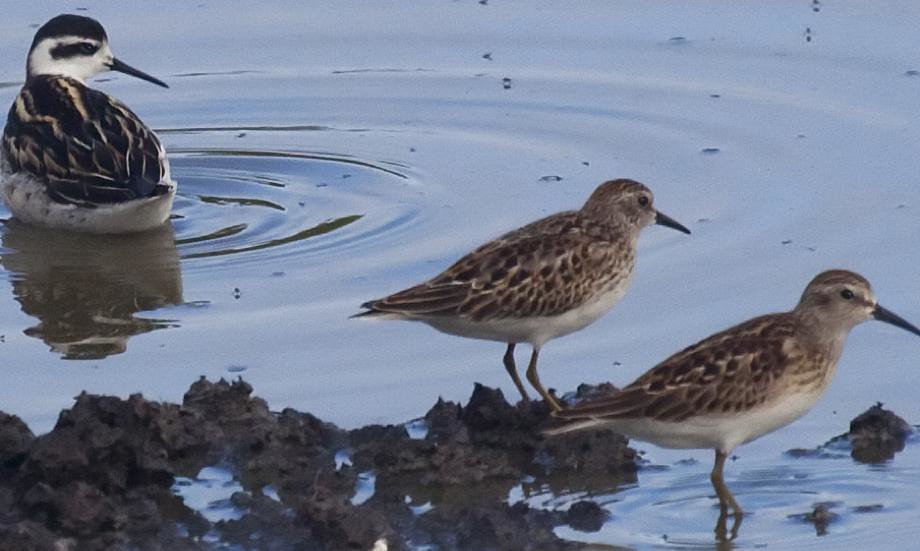
Red-necked phalarope, Phalaropus lobatus (formerly, Lobipes lobatus; protonym, Tringa lobata), also known as the hyperborean phalarope or as the northern phalarope. On the lower right side of the image are two least sandpipers, Calidris minutilla (formerly, Actodromas minutilla, Ereunetes minutillus, Erolia minutilla, and Pisobia minutilla; protonym, Tringa minutilla), also known as the American stint, least stint, or as the oxeye, photographed in a feedlot pond north of Manhattan (Riley County), Kansas. NOTE: this image has been altered. It has been cropped from the original so it has the proper dimensions for display on mobile media (Especially for android phones -- please leave a note in comments letting me know if this picture does/does not appear on your mobile phones!) You can still see the prettier -- and much larger -- original image by clicking on "velociraptorize".
Image: Dave Rintoul, 17 September 2011 (with permission) [velociraptorize].
Canon EOS 5D Mark II
Question: Both of these North American mystery birds pop up in the UK from time to time, can you identify their taxonomic families? Can you identify the species? Is a feedlot in Kansas a normal place to find these species?
Response: This is a winter-plumaged red-necked phalarope, Phalaropus lobatus, and two least sandpipers, Calidris minutilla. Both species are placed into the same taxonomic family of waders and shorebirds, Scolopacidae.
The phalaropes are fascinating because they have a sex-role reversal in their breeding system. The polyandrous females compete for males and for nesting territories, they are larger than males, more aggressive and more brightly coloured than males. The females seem to have things figured out correctly: after they've laid their eggs, they depart on their southward migration, leaving the males to incubate the eggs and raise the young.
The red-necked phalarope breeds in the Arctic regions of North America and Eurasia. This species is notable because it is one of the few shorebirds that winters on open water, spending their winters on tropical oceans. Knowing this, you would probably expect that they have some modifications to their feet to help them swim. And indeed they do: the genus name, Phalaropus ("coot-footed"), was inspired by the striking resemblance of the red-necked phalarope's lobed toes to those of coots. (Interestingly, Wilson's phalarope, Phalaropus tricolor, lack lobate toes and this is one of several reasons they are sometimes placed into the monotypic genus, Steganopus.)
Here's a short video showing the typical manic feeding behaviour of a red-necked phalarope, courtesy of Don DesJardin:
The two small shorebirds in the lower right of the image are least sandpipers, Calidris minutilla. These -- the tiniest of the shorebirds -- can be found during migration all across North America. Their small size and greenish or bright yellow legs set them apart from other (confusingly similar) shorebirds. Least sandpipers occasionally pop up in Europe, where they drive bird watchers crazy because they closely resemble the long-toed stint, Calidris (Erolia) subminuta. But the least sandpiper can be distinguished by its more compact, shorter-necked appearance, its shorter toes (good luck seeing its toes when the bird is poking around in the mud!), its vaguely paler plumage colours, and its bolder wingbar.
Embedded below is a video of a small flock of unbelievably cute least sandpipers feeding at Cibola National Wildlife Refuge, Arizona (Recorded by George Jameson; uploaded 28 January 2011):
You are invited to review all of the daily mystery birds by going to their dedicated graphic index page.
If you have bird images, video or mp3 files that you'd like to share with a large and (mostly) appreciative international audience here at The Guardian, feel free to contact me to learn more.
.. .. .. .. .. .. .. .. .. .. .. ..
twitter: @GrrlScientist
facebook: grrlscientist
email: grrlscientist@gmail.com
